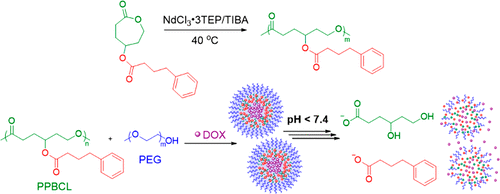当前位置:
X-MOL 学术
›
Biomacromolecules
›
论文详情
Our official English website, www.x-mol.net, welcomes your
feedback! (Note: you will need to create a separate account there.)
Histone Deacetylase Inhibitor (HDACi) Conjugated Polycaprolactone for Combination Cancer Therapy
Biomacromolecules ( IF 5.5 ) Pub Date : 2018-02-27 00:00:00 , DOI: 10.1021/acs.biomac.8b00221 Ruvanthi N Kularatne 1 , Katherine E Washington 1 , Chandima Bulumulla 1 , Erika L Calubaquib 1 , Michael C Biewer 1 , David Oupicky 2 , Mihaela C Stefan 1
Biomacromolecules ( IF 5.5 ) Pub Date : 2018-02-27 00:00:00 , DOI: 10.1021/acs.biomac.8b00221 Ruvanthi N Kularatne 1 , Katherine E Washington 1 , Chandima Bulumulla 1 , Erika L Calubaquib 1 , Michael C Biewer 1 , David Oupicky 2 , Mihaela C Stefan 1
Affiliation

|
The short chain fatty acid, 4-phenylbutyric acid (PBA), is used for the treatment of urea cycle disorders and sickle cell disease as an endoplasmic reticulum stress inhibitor. PBA is also known as a histone deacetylase inhibitor (HDACi). We report here the effect of combination therapy on HeLa cancer cells using PBA as the HDACi together with the anticancer drug, doxorubicin (DOX). We synthesized γ-4-phenylbutyrate−ε-caprolactone monomer which was polymerized to form poly(γ-4-phenylbutyrate−ε-caprolactone) (PPBCL) homopolymer using NdCl3·3TEP/TIBA (TEP = triethyl phosphate, TIBA = triisobutylaluminum) catalytic system. DOX-loaded nanoparticles were prepared from the PPBCL homopolymer using poly(ethylene glycol) as a surfactant. An encapsulation efficiency as high as 88% was obtained for these nanoparticles. The DOX-loaded nanoparticles showed a cumulative release of >95% of DOX at pH 5 and 37 °C within 12 h, and PBA release was monitored by 1H NMR spectroscopy. The efficiency of the combination therapy can notably be seen in the cytotoxicity study carried out on HeLa cells, where only ∼20% of cell viability was observed after treatment with the DOX-loaded nanoparticles. This drastic cytotoxic effect on HeLa cells is the result of the dual action of DOX and PBA on the DNA strands and the HDAC enzymes, respectively. Overall, this study shows the potential of combination treatment with HDACi and DOX anticancer drug as compared to the treatment with an anticancer drug alone.
中文翻译:

组蛋白脱乙酰酶抑制剂 (HDACi) 缀合聚己内酯用于癌症联合治疗
短链脂肪酸 4-苯基丁酸 (PBA) 作为内质网应激抑制剂用于治疗尿素循环障碍和镰状细胞病。PBA 也称为组蛋白脱乙酰酶抑制剂 (HDACi)。我们在此报告使用 PBA 作为 HDACi 与抗癌药物阿霉素 (DOX) 联合治疗 HeLa 癌细胞的效果。我们合成了γ-4-苯基丁酸酯−ε-己内酯单体,使用NdCl 3 ·3TEP/TIBA(TEP = 磷酸三乙酯,TIBA = 三异丁基铝)聚合形成聚(γ-4-苯基丁酸酯−ε-己内酯)(PPBCL)均聚物催化系统。使用聚乙二醇作为表面活性剂,由 PPBCL 均聚物制备负载 DOX 的纳米颗粒。这些纳米颗粒的封装效率高达 88%。负载 DOX 的纳米粒子在 pH 5 和 37 °C 下 12 小时内累积释放 >95% 的 DOX,并通过1 H NMR 光谱监测 PBA 释放。在 HeLa 细胞上进行的细胞毒性研究中可以明显看出联合疗法的效率,在使用负载 DOX 的纳米粒子处理后,仅观察到约 20% 的细胞活力。这种对 HeLa 细胞的剧烈细胞毒性作用是 DOX 和 PBA 分别对 DNA 链和 HDAC 酶双重作用的结果。总体而言,这项研究显示了与单独使用抗癌药物治疗相比,HDACi 和 DOX 抗癌药物联合治疗的潜力。
更新日期:2018-02-27
中文翻译:

组蛋白脱乙酰酶抑制剂 (HDACi) 缀合聚己内酯用于癌症联合治疗
短链脂肪酸 4-苯基丁酸 (PBA) 作为内质网应激抑制剂用于治疗尿素循环障碍和镰状细胞病。PBA 也称为组蛋白脱乙酰酶抑制剂 (HDACi)。我们在此报告使用 PBA 作为 HDACi 与抗癌药物阿霉素 (DOX) 联合治疗 HeLa 癌细胞的效果。我们合成了γ-4-苯基丁酸酯−ε-己内酯单体,使用NdCl 3 ·3TEP/TIBA(TEP = 磷酸三乙酯,TIBA = 三异丁基铝)聚合形成聚(γ-4-苯基丁酸酯−ε-己内酯)(PPBCL)均聚物催化系统。使用聚乙二醇作为表面活性剂,由 PPBCL 均聚物制备负载 DOX 的纳米颗粒。这些纳米颗粒的封装效率高达 88%。负载 DOX 的纳米粒子在 pH 5 和 37 °C 下 12 小时内累积释放 >95% 的 DOX,并通过1 H NMR 光谱监测 PBA 释放。在 HeLa 细胞上进行的细胞毒性研究中可以明显看出联合疗法的效率,在使用负载 DOX 的纳米粒子处理后,仅观察到约 20% 的细胞活力。这种对 HeLa 细胞的剧烈细胞毒性作用是 DOX 和 PBA 分别对 DNA 链和 HDAC 酶双重作用的结果。总体而言,这项研究显示了与单独使用抗癌药物治疗相比,HDACi 和 DOX 抗癌药物联合治疗的潜力。









































 京公网安备 11010802027423号
京公网安备 11010802027423号